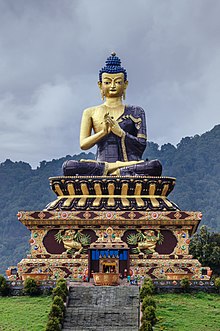
Back Boeddhisme Afrikaans Buddhismus ALS ቡዲስም Amharic Budismo AN Buddendōm ANG बौद्ध धर्म ANP البوذية Arabic بودية ARY بوذيه ARZ বৌদ্ধ ধৰ্ম Assamese
 | |
|---|---|
|
Basic terms | |
|
| |
|
People | |
|
Schools | |
|
Practices | |

Buddhism originated in the Indian Subcontinent, mainly in the North Indian Plain, based on the teachings of Siddhartha Gautama, later known as Gautama Buddha. A Buddha is one who is said to be awake to the truth of life.
Over the centuries, his teachings spread to Nepal, Central Asia, Tibet, Sri Lanka, Southeast Asia, China, Mongolia, Korea, Japan, and now Europe and North and South America. At least two major branches of practice and theory exist: Theravada Buddhism is most common in South East Asia; Mahayana further north. Buddhism exists in many different strands today, but all schools and sects share basic ideas. About seven percent of the people of the world are Buddhist.
While many people see Buddhism as a religion,[1] others see it as a philosophy, and others as a way of finding reality.[2][3]
- ↑ Chambers Dictionary, 2006; Merriam-Webster's Collegiate Dictionary, 2003; New Penguin Handbook of Living Religions, 1998; Dewey Decimal System of Book Classification
- ↑ For example: Thich Nhat Hanh, Path White Clouds|Old Path White Clouds Archived 2023-02-19 at the Wayback Machine For example: Dorothy Figen, Is Buddhism a Religion?[permanent dead link]
- ↑ For example: Narada Thera, Buddhism in a Nutshell, http://www.buddhanet.net/nutshell03.htm Archived 2008-02-17 at the Wayback Machine